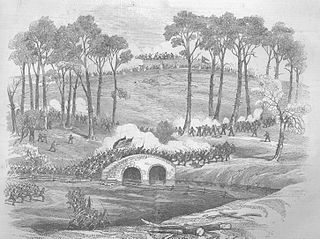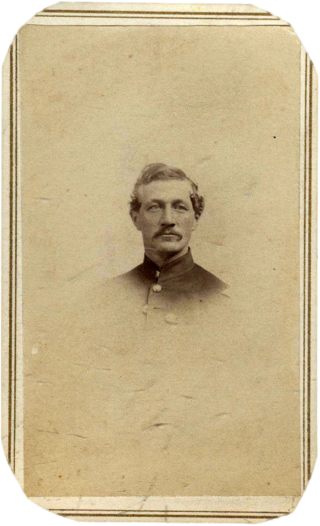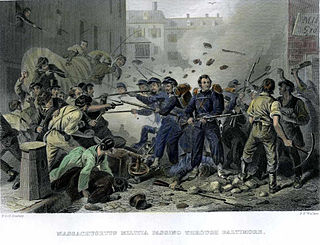
The 28th Massachusetts Infantry regiment was the second primarily Irish American volunteer infantry regiment recruited in Massachusetts for service in the American Civil War. The regiment's motto was Faugh a Ballagh

The 22nd Regiment Massachusetts Volunteer Infantry was an infantry regiment in the Union army during the American Civil War. The 22nd Massachusetts was organized by Senator Henry Wilson and was therefore known as "Henry Wilson's Regiment." It was formed in Boston, Massachusetts, and established on September 28, 1861, for a term of three years.

The 9th New York Heavy Artillery Regiment, U.S. Volunteers was a regiment in the American Civil War. It was one of the nine Heavy Artillery regiments to suffer over 200 killed. It is also mentioned as one of Fox's 300 Fighting Regiments.

John Milton Deane was an American Civil War Medal of Honor recipient and a major in the United States Army.

William Francis Bartlett was a general in the Union Army during the American Civil War and, later, an executive in the iron industry.

The 9th Regiment Massachusetts Volunteer Infantry was a military unit from Boston, Massachusetts, USA, part of the Army of the Potomac during the American Civil War. It is also known as "The Fighting Ninth". It existed from 1861 to 1864 and participated in several key battles during the war. The unit is an Irish heritage unit, with many volunteers having been born in Ireland.

32nd Regiment Indiana Volunteer Infantry was a Union Army infantry regiment during the American Civil War. It was also known as Indiana's "1st German" regiment because its members were mainly of German descent. Organized at Indianapolis, the regiment's first recruits mustered into service on August 24, 1861. From 1861 to 1865, the 32nd Indiana was attached to the first Army of the Ohio and the Army of the Cumberland, where it served in the Western Theater.
The 61st Regiment Massachusetts Volunteer Infantry was an infantry regiment raised for one year's service in the Union Army during the American Civil War from 1864 to 1865.

The 21st Massachusetts Infantry Regiment was an infantry regiment in the Union Army during the American Civil War. It was organized in Worcester, Massachusetts and mustered into service on August 23, 1861.

James Adams Cunningham was a volunteer officer in the Union Army during the American Civil War.

The 2nd Regiment Massachusetts Volunteer Infantry was an infantry regiment in the Union Army during the American Civil War. Major George H. Gordon, a West Point graduate and veteran of the Mexican–American War, organized the unit's recruitment and formation. The 2nd Massachusetts was trained at Camp Andrew in West Roxbury, Massachusetts on the site of the former Transcendentalist utopian community, Brook Farm. Roughly half the regiment was mustered in on May 18, 1861 and the remainder on May 25, 1861 for a term of three years. The regiment saw extensive combat as part of the Army of the Potomac particularly during the Battle of Antietam and the Battle of Gettysburg.

The 7th Regiment Massachusetts Volunteer Infantry was an infantry regiment in the Union army during the American Civil War. It was formed on June 15, 1861, in Taunton. Its original commander was Colonel Darius N. Couch who would eventually be promoted to command the II Corps of the Army of the Potomac and, after that, the Department of the Susquehanna.

The 29th Regiment Massachusetts Volunteer Infantry was an infantry regiment in the Union army of the United States during the American Civil War. The regiment was organized in December 1861 when three new companies were attached to a battalion of seven Massachusetts companies that had been in active service since May 1861. These seven companies had been recruited to fill out the 3rd Massachusetts and 4th Massachusetts regiments and had signed on for three years of service. When the 3rd and 4th Massachusetts were mustered out in July 1861, the seven companies that had signed on for three years were grouped together to form a battalion known as the Massachusetts Battalion. Finally, in December 1861, three more companies were added to their roster to form a full regiment and the unit was designated the 29th Massachusetts.

Oliver Edwards was a machine company executive, an inventor, and a volunteer officer in the Union Army during the American Civil War.

The 12th Regiment Massachusetts Volunteer Infantry was an infantry regiment in the Union army during the American Civil War. It was formed on June 14, 1861, in Boston, Massachusetts. Its original commander was Colonel Fletcher Webster, son of the famed U.S. Senator from Massachusetts, Daniel Webster. The unit was known as the Webster Regiment after its first colonel.
The 3rd Massachusetts Volunteer Cavalry Regiment was a cavalry regiment that served in the Union Army during the American Civil War. It was organized by consolidating the 41st Massachusetts Mounted Infantry and the 2nd Battalion Massachusetts Cavalry on June 17, 1863. The regiment served with the XIX Corps, Army of the Gulf during the Red River Campaign in 1864. Its heaviest combat during this campaign took place during the Battle of Sabine Crossroads.

The 3rd Massachusetts Volunteer Militia Regiment was a peacetime regiment of infantry that was activated for federal service in the Union Army for two separate tours during the American Civil War. The regiment consisted of companies from Plymouth and Bristol Counties.

The 5th Regiment Massachusetts Volunteer Militia was a peacetime infantry regiment that was activated for federal service in the Union army for three separate tours during the American Civil War. In the years immediately preceding the war and during its first term of service, the regiment consisted primarily of companies from Essex County as well as Boston and Charlestown.

The 6th Regiment Massachusetts Volunteer Militia was a peacetime infantry regiment that was activated for federal service in the Union army for three separate terms during the American Civil War (1861-1865). The regiment gained notoriety as the first unit in the Union Army to suffer fatal casualties in action during the Civil War in the Baltimore Riot and the first militia unit to arrive in Washington D.C., in response to President Abraham Lincoln's initial call for 75,000 troops. Private Luther C. Ladd of the 6th Massachusetts is often referred to as the first Union soldier killed in action during the war.

The 57th Regiment Massachusetts Volunteer Infantry was a regiment of infantry that served in the Union Army during the American Civil War. It was one of the four "Veteran Regiments" raised in Massachusetts during the winter of 1863–64. Recruits of these regiments were required to have served at least nine months in a prior unit. Colonel William F. Bartlett, at age 24 already a veteran of three regiments, organized the recruiting and formation of the 57th Massachusetts and served as its first commanding officer.



















